Armored personnel carrier FIAT 665NM Protetto (Italy)
Defeats in North Africa seriously hit the fleet of automotive and military equipment of the Italian army. Because of this, the military, ordering new armored personnel carriers, were forced to demand the maximum simplification and cheapening of such equipment. As a result, all new projects were based on existing serial car chassis. The FIAT 665NM Protetto machine is no exception to this rule. To reduce costs, it was decided to take the finished truck and replace the unprotected cab and bodywork with armored units.
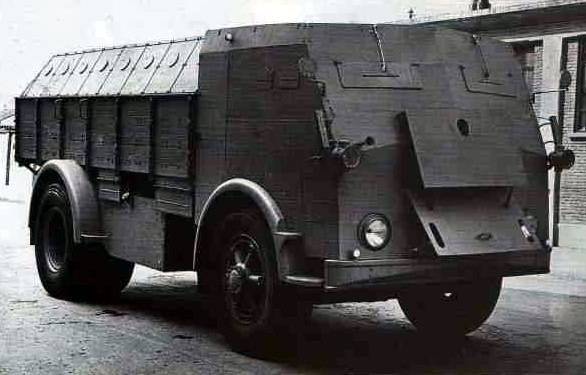
General view of the armored personnel carrier. Photo Aviarmor.net
The newest FIAT 665NM truck was taken as a basis for the new armored personnel carrier. This car was one of the representatives of the FIAT 666N family of vehicles. Within this family, several trucks and buses with different characteristics and equipment were produced. In this case, the main part of the aggregates of all machines, regardless of the configuration, was common to the whole family. The first machines of the 666N family went off the assembly line in the 1939 year, and the production of later models continued to the 48. At the time of the announcement of the requirements of the military department, FIAT specialists were developing a new truck for the army, which received the 665NM index.
The FIAT 665NM truck was designed as a transport vehicle for the army. The intended method of application required to make some changes in the design of the power plant, transmission and chassis. Thus, the previous 666N family of vehicles had a wheel formula 4х2 with rear driving wheels. Army trucks were all-wheel drive and had the appropriate design of the transmission. In addition, some other changes were made to improve performance.
The FIAT 665NM, which was proposed as the basis for the new armored car, had a frame structure traditional for that time and a bonded cabin layout. In front of the frame, inside the casing in the cabin, fit a six-cylinder diesel engine FIAT 366 with a power 110 hp. A mechanical transmission was associated with it, distributing torque to all four wheels. As part of the two-axle undercarriage used leaf springs. The front axle with steered wheels had single-pitch wheels, the rear axle was equipped with twinned ones. The fuel tank with a capacity of 135 l was located to the right of the frame.
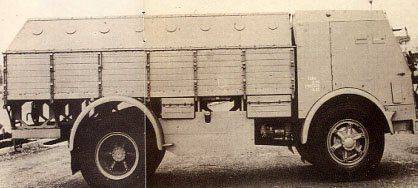
One of the earliest serial samples in a monotonous light desert color. Photo of Wikimedia Commons
A promising armored personnel carrier based on the FIAT 665NM truck was given the simplest designation. The word “protected” was added to the name of the base machine, as a result of which the project was called FIAT 665NM Protetto. In addition, there is an alternative designation Scudato.
It was proposed to install an original hull armored hull on the base chassis. Metal sheets with thickness from 7,5 to 10 mm should be mounted on the frame. To simplify the assembly, the housing was divided into two compartments of different sizes and shapes. Instead of the cab of the base truck, it was proposed to install an armored unit of a similar design. The frontal projection of the machine was protected by four straight sheets, connected at different angles. In this case, the central joint of the sheets protruded forward, and the upper pair of sheets was installed with a large angle to the vertical compared to the lower.
In the central part of the bottom sheets a large window was provided for cooling the radiator. Machines of different series received various front-end units. Some armored personnel carriers had a relatively complex system of two covers that were hinged and controlled from the cockpit. Others were equipped with simple armored blinds. On the sides of the radiator window were lights. In the upper frontal sheets were provided two inspection hatches with lowered covers. The dimensions of the hatches in different armored vehicles could be different. In some Scudato, the right hatch was noticeably larger than the left.
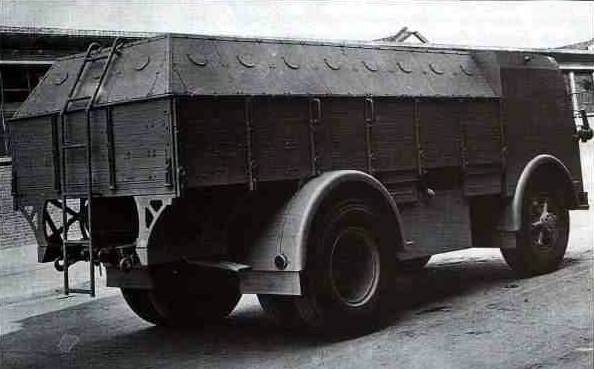
Back view. Photo of Wikimedia Commons
The vertical sides of the cabin with large doors that opened back defended the driver from the side of the fire. At the door provided for the viewing gap. In some series of armored personnel carriers, the upper part of the side was tilted inward; on the others, the entire board was straight. Unlike the troop compartment, the driver’s cabin had a roof. An interesting feature of the FIAT 665NM Protteto BTR was the layout of the command and control unit. The driver’s workplace was placed at the left side, while in most Italian armored vehicles of the time the control post was on the right. Such a reconfiguration was associated, among other things, with a non-standard landing method.
The entire landing or cargo was placed in the second section of the armored corps, which took the place of the body of the base truck. This unit had a very simple design and was a box with inclined upper parts of the sides and the stern. The troop compartment did not have a front wall, which provided free access to the driver’s cabin. The landing was planned to be carried out only through the right door of the department of control. Side or stern doors were absent. Nevertheless, on some armored personnel carriers installed stairs for landing through the stern sheet.
Along the sides of the troop compartment were located benches for transporting soldiers. Each BTR could take on board up to 20 people or a load of the corresponding weight. The large capacity of the car contributed to the design of the base truck: due to the large length of the frame, it was possible to make a relatively large armored hull.
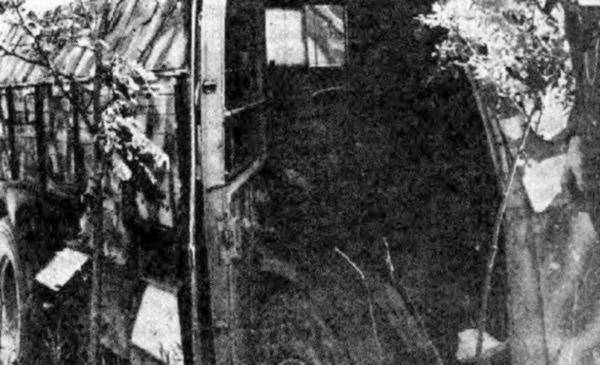
Front right door. Photo Aviarmor.net
The landing had the opportunity to fire from personal weapons. For this purpose, a large number of embrasures with flaps were provided on the upper inclined part of the sides and the stern. In each of the boards there were eight such devices, two more were installed at the stern.
The armored personnel carrier’s own armament consisted of one Breda Mod.30 machine gun or any other weapon with similar parameters. Machine gun mount was installed in the back of the driver's roof. Thus, the shooter could fire at targets in the front hemisphere, and protection against attacks from the side or rear was provided with personal weapons and embrasures.
Like the base truck, the new FIAT 665NM Protetto armored personnel carrier was quite large and heavy. Its total length was 7345 mm with a width of 2,7 m and a height of 2,73 m. The curb weight of the machine with two dozen soldiers reached 9 t. Thus, the FIAT BTR was the largest and heaviest vehicle of its class developed in Italy during World War II.
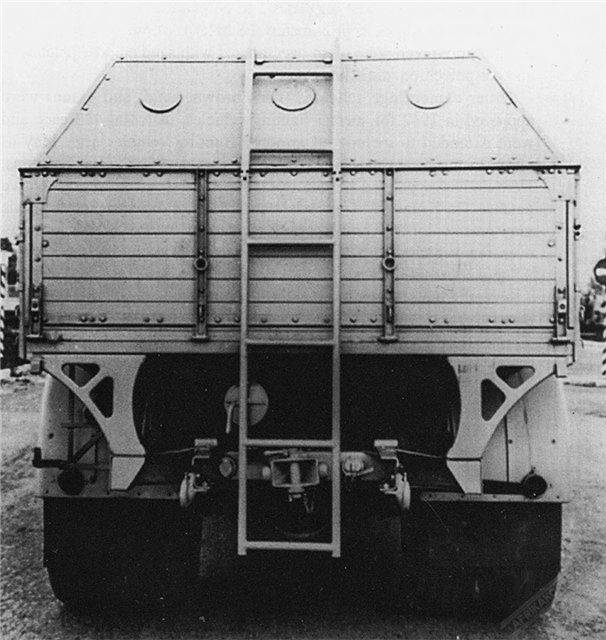
Feed cars. Clearly visible staircase to rise in the troop compartment. Photo Aviarmor.net
Engine power 110 HP allowed to achieve relatively high driving characteristics. On the highway, the armored personnel carrier was speeding up to 55-57 km / h. 135 l fuel was enough for 390 km of the way. When driving on rough terrain, despite the four-wheel drive, the maximum performance of the machine significantly reduced.
At the beginning of 1942, one of the early FIAT 665NM trucks built for the army became the basis for the new armored personnel carrier. A prototype of a promising machine was put to the test and showed good performance. In some respects, it was inferior to other vehicles that were also tested, but surpassed them in capacity of the troop compartment and other characteristics.
According to the results of comparative tests of several machines, it was decided to put in the FIAT 665NM Protetto and FIAT-SPA S37 series. Soon, agreements were signed on the supply of serial equipment of two models. In accordance with the contract, FIAT was to build and transfer to the troops three hundred Scudeto armored personnel carriers over the next few years. In addition, at the same time, mass production of basic trucks, which were also ordered by the military, was unfolding.
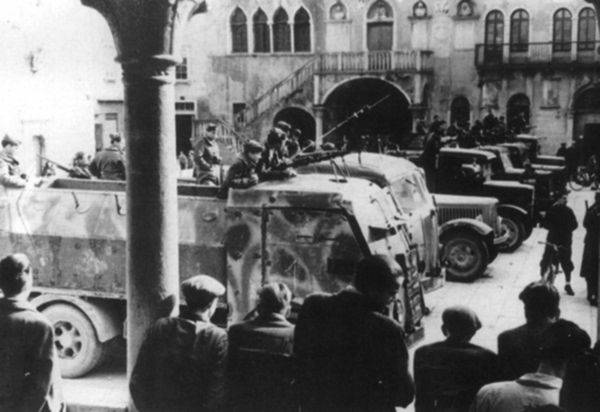
BTR in the army. Photo Aviarmor.net
The command of the Italian army intended to use new equipment during the North African campaign. For this, in particular, the manufacturer dyed the first production machines in light sand colors. Subsequently, after the end of the battles in Africa, the new cars received camouflage coloring traditional for the Italian army.
Shortly after the start of mass production of the BATF FIAT 665NM Protetto, the Italian industry faced a number of serious problems. For this reason, only the first few armored personnel carriers were built in full accordance with the original project. In the future, the specialists of the manufacturer had to "improvise", making various changes to the design. Depending on the current situation, such changes could affect only a few minor details or lead to a serious reworking of the structure.
In the course of serial production, they abandoned the complex grille flap, going to a simple panel of blinds. In addition, the size and shape of the driver's inspection hatches changed. The wings of the wheels on different machines had a different shape and were caused by the presence of components. In this case, the design of the rear part of the case did not undergo any noticeable changes, which was facilitated by its simplicity. Some machines received a frame for the installation of an awning, consisting of curved rods. It was possible to stretch the fabric awning and thus protect the troop compartment from the sun and rain.
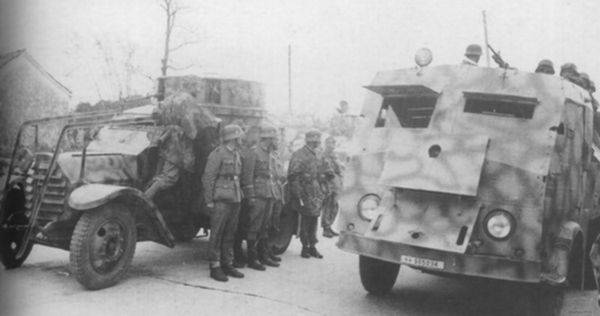
The Lancia 1Z armored car (left) and the FIAT 665NM Protetto BTR in one of the German units. Photo Aviarmor.net
There is information about the existence of FIAT 655NM Protetto armored personnel carriers built on the basis of non-standard chassis. Due to the shortage of trucks 655NM, the manufacturer had to install armored hulls on other vehicles of the 666N family. Such chassis were distinguished by less powerful engines and 4x2 wheel formula, which is why armored personnel carriers based on them had less high mobility and maneuverability characteristics.
The main reason for using non-standard chassis was the lack of required trucks. In the end, all this led to the fact that by the beginning of the fall of 1943, the FIAT company had time to build and transfer no more than 105-110 armored vehicles to the army. All this equipment was sold in different parts and was actively used for the transportation of goods and personnel.
Some of the cars built were destroyed during the fighting in Italy. The rest after the surrender were captured by German troops. After the creation of the puppet Italian social republic, the Germans transferred part of the FIAT 665NM Protetto that remained with them to the allies. After that, for some time armored personnel carriers were used in two armies.
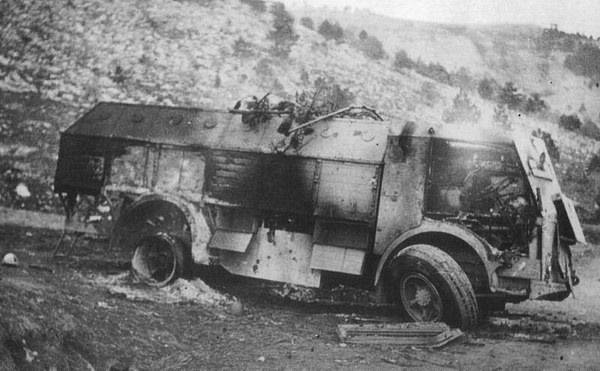
Broken and burned armored personnel carrier, the result of the partisans. 1944 g. Photo by Aviarmor.net
After the outbreak of hostilities in the Balkans, the Italian forces clashed with the local partisan movement. Over time, the activity of the Resistance grew, because of which Italy and Germany had to devote more and more forces to conduct counterguerrilla operations. In such events, various armored vehicles were used, including the 665NM Protetto BTR. It is noteworthy that such machines could perform various functions, including playing the role of a protected transport for the transport of goods through hazardous areas.
Regular guerrilla attacks led to permanent losses of equipment, including the Scudeto armored personnel carriers. Until the end of the war only a few dozen such machines survived. The remaining equipment was no longer of interest to the new Italian army. Therefore, in the 1945-46, the vast majority of old armored vehicles, including all FIAT 665NM Protetto armored personnel carriers, were written off and sent for recycling. Attempts to preserve such equipment for museums were not undertaken.
On the materials of the sites:
http://wardrawings.be/
http://aviarmor.net/
http://italie1935-45.com/
http://panzer-ozak.it/
Information